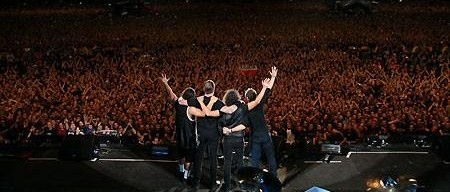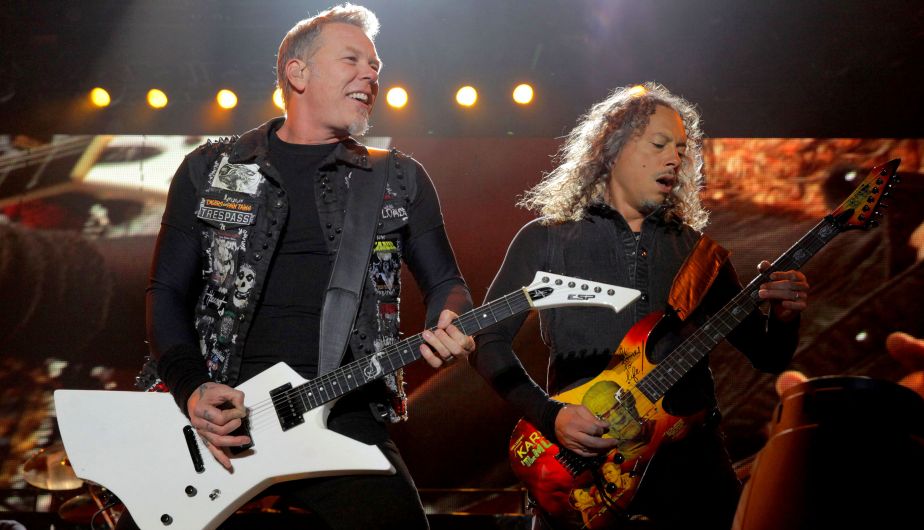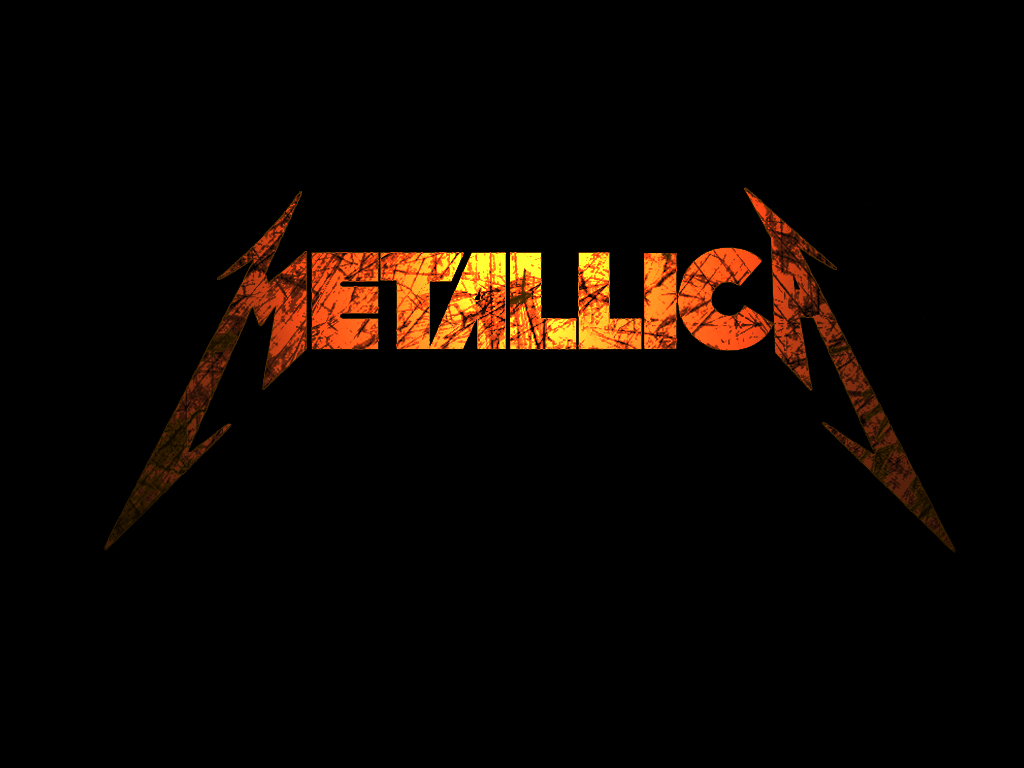History-Band

(puede hacer click en el titulo de sección para ver más)
History-Band
Metallica, one of the biggest selling acts in American history, were born on October 28, 1981 when drummer Lars Ulrich and guitar player/singer James Hetfield got together via Ulrich’s LA Recycler newspaper ad. Soon, the two had recruited Hetfield’s friend and housemate Ron McGovney to play bass, Dave Mustaine to play lead guitar, and taken the name Metallica after a suggestion from Bay Area metal scene friend Ron Quintana. Their ascent was to be relatively quick, driven by sheer work-rate, effort and a rare musical chemistry. After hitting the opener’s circuit in LA (where they supported the likes of Saxon) they recorded their first ever demo No Life ‘Til Leather. The tape-trading circuit went crazy for it, and after repeatedly well-received shows in the Bay Area, Metallica found themselves relocating there after convincing bassist Cliff Burton to leave his band Trauma and replace McGovney.
.jpg)
East Coast metal merchant Jon Zazula pitched the band on an album deal with his indie label Megaforce Records and 1983 found them traveling to New York in a stolen U-Haul to record their first album. Shortly after arriving in New York in April 1983, Mustaine was replaced by Exodus shredder Kirk Hammett and the boys hit the studio for the first time. The resulting debut album, Kill ‘Em All, exploded onto the scene later that year brandishing punk-encrusted, crunchy metal riffery, the likes of “The Four Horsemen,” “Whiplash” and “Seek and Destroy” that were hailed as instant classics. The stellar reception in the metal community allowed them to quickly make their second album Ride The Lightning with producer Flemming Rassmussen in Copenhagen at Sweet Silence Studios during the summer of 1984. With their writing chemistry maturing at an alarming rate of knots, classic compositions such as “For Whom The Bell Tolls” and “Fade To Black” sat proudly with the aggression of “Fight Fire With Fire” and “Creeping Death.” Q Prime Management and Elektra Records both moved quickly to take the band on by the Fall of ’84, and with the road getting busier and more international, the bands’ stature rapidly grew.
In late 1985, the Rassmussen/Sweet Silence combination provided the underpinning for Master Of Puppets, the band’s third album, which was mixed in LA with Michael Wagener and released in March 1986. “Battery,” the title track and epic instrumental “Orion” were among the astounding compositions, and having secured a support slot with Ozzy Osbourne, Master of Puppets hit the top 30 album charts and expanded their fan base beyond comprehension. It was some ascent. Metallica appeared unstoppable. But a heinous challenge was to be thrown at them when on September 27, 1986, they suffered a tragedy beyond words. On tour in Sweden, during an overnight drive the bands' tour bus skidded out of control and flipped, killing Cliff Burton. His influence on the musical growth of the band had been enormous, combining the DIY philosophies of jamming and experimenting with an acute knowledge of musical theory. Faced with having to find a new path after 40+ auditions they tapped Jason Newsted from Flotsam & Jetsam to take over bass duties. The quartet immediately jumped into a tour and then quickly recorded an EP of cover tunes titled The $5.98 E.P. - Garage Days Re-Revisited (the band literally did the dirty work in Ulrich's garage, which they helped refit into a small studio space by hand themselves!).
The band recorded their fourth full-length album, ...And Justice For All, first with Rassmussen again taking the helm (this time at One On One Studios in LA) after some initial work with Mike Clink (of Appetite for Destruction fame) didn’t work out. Released in August 1988, the album reached #6 on the US charts, while the band was busy blowing headliners Van Halen off the stage during the Monsters Of Rock tour before embarking upon their first headline worldwide arena tour. Metallica also made their very first music video for "One,” a dark, monochromatic, violent, emotional piece which underscored Metallica’s thorough uniqueness. Then came stratospheric, explosive, cacophonous worldwide success.
In 1991, Metallica released their self-titled album – better known by fans as The Black Album. New producer Bob Rock focused the band on a fuller sound with simpler arrangements, and it went straight to number one all over the world…and didn’t really leave for a couple of years, selling in excess of 16 million copies worldwide, spawning several legitimate singles, and earning various industry accolades, including a Grammy, MTV and American Music Awards. “Enter Sandman” remains one of their signature anthems, whilst their first full foray into something more balladic, “Nothing Else Matters,” empathized with the heartstrings of millions. The tour that accompanied it was equally gargantuan, close to 300 shows in three years, and pushing the band to limits they didn’t know they could reach. It also featured the famous joint-headline stadium tour with Guns N’ Roses and yielded the first-ever official live album Live Shit: Binge & Purge, a road-case-shaped box-set containing all manner of intimate tour ephemera from riders to faxes. Aside from 1994’s 51 date Shit Hits the Sheds tour, time was spent regrouping and recovering from the relentlessness of their recent past, as well as writing the next Metallica album. Load was released in June 1996, and heralded a deeper exploration of the band’s musical style. Loose, powerful and a confident step away from The Black Album, Load sold five million-plus copies; so many strong songs were written, that a second album, Reload, came in 1997. The tour was a menagerie of technologic feats and tricks amidst cracking live performances across a massive stage-set, all of which was captured on the DVD release Cunning Stunts.

1998 saw the band collect their covers from the two previous Garage Days sessions and various b-sides as well as slamming down 11 brand new covers with the subsequent Garage, Inc. double disc release a reminder of their musical lives and loves. That insatiable search for new pastures led them to 1999’s San Francisco Symphony project with conductor/composer Michael Kamen pulling the metaphoric strings, resulting in the release later that same year of the double disc S&M. Recorded over two nights at the Berkeley Community Theater, the live shows and album saw Metallica further adding to their musical legacy and reputation for always seeking new challenges and refusing to rest on past creative achievements.
The turn of the century was to prove chaotic yet ultimately extremely progressive. The year 2000 kicked off with a short arena tour in the Midwest and the summer brought the US stadium headlining tour Summer Sanitarium. 2001 was set aside to begin work on a new original studio album, but the year started with yet another major change as Jason Newsted and the band parted ways in January. The remaining three members worked on new music with producer Bob Rock filing in on bass until in the middle of 2001 when Hetfield arrived at a crossroads in his life, which meant he needed to step away and rehabilitate on several levels. When the band reconvened in the spring of 2002, a new energy and verve was in place as communications were re-established on all levels, and with Rock on bass as well as producing, St. Anger was the first album made at their new HQ studio. Gloriously unfettered by constraints, it is an album which in hindsight was to set the Metalli-template for the next decade, and the music is that of a hungry, edgy, feral and angry band. Released in June 2003, the band excitedly took to the road with new bassist Robert Trujillo (Suicidal Tendencies/Infectious Grooves/Ozzy Osbourne), his easy-going demeanor and ferocious finger-plucking style giving him the edge in auditions Gigs came quickly, from four nights of “rehearsal” for fan club members only at SF’s Fillmore to three club shows in a sweltering Paris, France promotional day, before a set of European stadium headliners. In the US, a new Summer Sanitarium tour followed for another series of stadium sell-outs. There was also the small matter of their soon-to-be ground-breaking documentary Some Kind Of Monster, the documentary film made by Joe Berlinger and Bruce Sinofsky between 2001 and 2003. The project had started as a marketing piece, but ended up being one of the most important, revealing documentations of artistic (and personal) struggle-to-redemption ever committed to film.
2004 saw the Madly In Anger With The World tour present its in-the-round two hour thirty minute self on over 80 dates in the US alone, Some Kind of Monster saw its theatrical release start rolling across the world in July, and as the final show was played in San Jose on November 29, 2004, it was realized that the band had once again found itself touring and working for the better part of two and half years. Thus 2005 was a designated “re-charge” year, and it remained as such, save for two gigs with the Rolling Stones at AT&T Park in November. The break saw Metallica once again re-evaluate their creative options, and thus in early 2006 they decided to make the new album with a new producer, Rick Rubin, who encouraged the band to go back to their early roots. Live shows continued to offer both release and building blocks for the writing process, new territories such as South Africa being visited, but the writing process was in full-swing, and with engineer Greg Fidelman doing day-to-day sessions as Rubin oversaw everything, Death Magnetic was released on September 12, 2008. A more organically made album, it was the perfect fusion of Metallica’s early past and their increasingly experimental future, and the popular response was huge, the album smashing album charts at number one everywhere.
The subsequent tour saw Metallica start in October 2008 and end deep in 2010 with shorter stretches and longer breaks between dates meaning burn-out was never an issue. Amidst the World Magnetic dates came a live DVD Orgullo, Pasión y Gloria: Tres Noches en la Ciudad de México (directed by Wayne Isham) plus a French-only DVD from the Roman amphitheater in Nimes, France, titled Français Pour Une Nuit. Oh yes, and in April 2009 there was also the small matter of being inducted into the Rock And Roll Hall of Fame with the band bringing all their friends, family and long-time supporters with them to Cleveland, Ohio to celebrate. Later that year they continued the celebration at the Rock and Roll Hall of Fame 25th Anniversary show on October 30, 2009 at Madison Square Garden performing collaborations with fellow Hall of Famers Lou Reed, Ozzy Osbourne and Ray Davies of The Kinks.

On June 16, 2010, Warsaw, Poland saw the first of several monumental Big 4 shows featuring Metallica, Slayer, Megadeth and Anthrax... the fabled Big 4 of thrash, and a live DVD, Blu-ray and box-set titled The Big 4: Live From Sofia, Bulgaria was released. On November 21, 2010 in Melbourne, Australia Metallica played the last show of the World Magnetic tour, before heading home for a spot of hibernation, and a planned “gap” year of recuperation… …instead, 2011 saw them seduced into a collaboration with one of the legendary Godfathers of punk and alternative music, Lou Reed (who had pushed for such a thing since the Hall of Fame gig in '09) on an album project based around writing by Frank Wedekind about a 19th century French prostitute named Lulu, which was then reinterpreted by Reed. He, in turn, built a series of song frameworks and invited Metallica to come in and fill the space spontaneously. Thus work began in late April at HQ and the subsequent album, Lulu, was released on October 31, 2011. While not well received, it once again served notice that Metallica does what Metallica wants and needs for its own creative spirit. As Lulu was being released, new adventures were being enjoyed in the unchartered waters of the Middle East and India before a jaunt through Europe performing short TV show sets with Reed in November… leaving MORE than enough time to plan four nights at The Fillmore (December 5,7,9 and 10) celebrating their 30th Anniversary. The band re-learned their entire canon of material backwards and drafted a menagerie of special guests from Diamond Head to Danzig to Rob Halford to Dave Mustaine and plenty in between. Shows were for fan club members only with the decidedly 1981 ticket price of $6 followed closely by the release of four previously unavailable tracks from the Death Magnetic sessions as the Beyond Magnetic EP, first through iTunes and then on CD and vinyl.
2012 saw the band casually announce that they were producing their own live music festival, Orion Music + More on June 23rd and 24th in Atlantic City, a visionary mixture of genres and the band member’s own cultural tastes reflected over two days. Further, they were to headline each night, the first seeing a full performance of Ride the Lightning and the second, a full performance of The Black Album. Complete with each member curating a theme area (James hosted custom vehicles, Lars showed movies in a “cinema” and hosted guests, Rob hosted skateboarding and Kirk displayed his horror collection via a crypt) and a Metallica museum, it was an extraordinarily ambitious project which was to see one more year in Detroit before going on hiatus, perhaps to be re-launched down the road. Deciding that they wanted to push the creative boat out even further, the guys went full-throttle on a film project idea first drafted a couple of years earlier. An elaborate stage was built, featuring elements from all the band’s previous tours, and the band rehearsed the live portion of the shoot over a sold-out eight night run in Mexico City during the summer of 2012, followed quickly by filming shows in Edmonton and Vancouver. Towards the end of 2012, Metallica also announced the creation of their own label, Blackened Records, which subsequently issued its first release, a live DVD titled Quebec Magnetic and shot on the World Magnetic tour in Quebec City.

May 2013 saw Metallica begin what would become a regular engagement with the San Francisco Giants baseball team, staging a Metallica night where Metallica-themed activities and events occurred during a Giants game (including Hetfield and Hammett playing the national anthem live for the first time in their careers). The road was hit in earnest, including the bands’ first-ever shows in China before the finished film Metallica Through The Never was released in IMAX theaters on September 27th. An ambitious weave of concert footage with a post-apocalyptic narrative outside the gig itself, starring Dane DeHaan (The Amazing Spiderman 2, Chronicle) and directed by Nimród Antal, it was a unique, peerless piece. Yet whilst critically praised for its exciting (and visionary) approach, it failed to smash the box-office druing its theatrical run. Not that Metallica sat around waiting for the numbers. The road had already been enjoying a more expansive exploration for most of the year, with visits to several continents leaving them close to completing shows on all seven as 2013 drew to a close. The final one? Antarctica. Un-played by any band. Until December 8, 2013, when the band performed at the Carlini Base under a custom-built Geo-dome in front of a small group of Coca-Cola contest winners and the community scientists. This made them the first band to play on all seven continents in the same calendar year. That… is how to close out a year! 2014 saw Metallica continuing to work on a series of ideas for the forthcoming album whilst also continuing to seek new challenges. They performed “One” with Chinese pianist Lang Lang at the 56th Annual Grammy Awards, and they also accepted an invitation to play the world famous Glastonbury Festival, another first. The result was, unsurprisingly, an overwhelmingly positive experience. The band also continued touring with their Metallica By Request tour, where fans were invited to request songs to be performed live at South American shows and the by now standard European summer run.
2015 has already seen Metallica complete their third annual SF Giants night, inaugurate a similar fun time with the San Jose Sharks and honor the Golden State Warriors by performing the National Anthem prior to game 5 of the NBA Finals in Oakland, California. They have also headlined the first Rock in Rio festival in the US, taking place in Las Vegas, NV, continued to play European summer shows and headlined Lollapalooza in Chicago. Work is also continuing on new music for the next Metallica album, but there remains no confirmed release date… to be continued, with the usual surprises and legendary lack of compromise intact.
